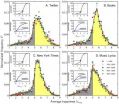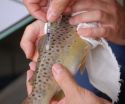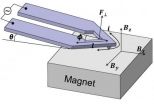(Press-News.org) A new study published in the journal Nature Medicine by NYU Cancer Institute researchers, shows how the cancer causing gene Notch, in combination with a mutated Polycomb Repressive Complex 2 (PRC2) protein complex, work together to cause T- cell acute lymphoblastic leukemia (T-ALL).
T-ALL is an aggressive blood cancer, predominately diagnosed in children. It occurs when one lymphoblast, an immature white blood cell, turns malignant, multiplying uncontrollably and spreading rapidly throughout the body. If left untreated, the disease can be fatal in a few weeks. Cancer-causing Notch mutations in T-ALL are well established, yet the detailed molecular mechanism mediating this Notch-induced cancer cell transformation was unknown until now.
"Our study presents new insight into how Notch acts in an antagonistic mode with PRC2 to promote T-ALL," said senior author, Iannis Aifantis, PhD, associate professor in the Department of Pathology and a member of the NYU Cancer Institute, an NCI-designated cancer center at NYU Langone Medical Center. "Moreover, our study shows frequent genetic inactivation on the genetic loci encoding for PRC2 components, inhibits its normal role as a gene expression regulator and further proves the tumor suppressor role of the complex in this disease."
The study shows a new dynamic interplay between Notch and PRC2 function. In the study, researchers analyzed Notch-driven epigenetic gene expression regulation changes in T-ALL. Findings show a clear loss of PRC2 function from the sites of Notch1 binding. In addition, researchers found recurrent gene mutations and deletions of the components of PRC2 in T-ALL patient samples. In the study, loss of PRC2 function fueled the Notch mutation. This provides evidence for a central role of deregulation of PRC2 in Notch-induced T-ALL.
"The inactivation of PRC2 complex due to Notch in T-ALL constitutes an important pathogenetic event in the formation of this potentially deadly disease," said lead author of the study Panagiotis Ntziachristos, PhD, of the Department of Pathology at NYU Langone. "The PRC2 genetic alteration amplifies the Notch oncogene's communication signals leading to T-ALL. Our study experiments uncover a specific epigenetic switch during the progression of the disease that can be further exploited for the development of targeted epigenetic therapies."
The study shows T-ALL as an epigenetic disease, regulated by a subtle equilibrium between oncogenes and tumor suppressors. Oncogenes like Notch can infiltrate the normal function of PRC2 in specific gene loci leading to cancerous cell transformation. Mutations in PRC2 assist oncogenes like Notch by altering their DNA gene expression.
"Our studies offer new therapy avenues for the treatment of T-ALL," said Dr. Aifantis. "The detection of new genetic alterations in T-ALL provides a new platform for selecting potential treatment strategies for the disease. Drugs that can target histone demethylases, enzymes that catalyze the H3K27me3 modification, could be used alone or in combination with Notch1 inhibitors for the treatment of the disease."
INFORMATION:Funding for this study was provided by the Howard Hughes Medical Institute, National Cancer Institute, The Leukemia and Lymphoma Society and the NYU Feinberg Lymphoma Fund.
About NYU Langone Medical Center
NYU Langone Medical Center, a world-class, patient-centered, integrated, academic medical center, is one on the nation's premier centers for excellence in clinical care, biomedical research and medical education. Located in the heart of Manhattan, NYU Langone is composed of three hospitals – Tisch Hospital, its flagship acute care facility; the Rusk Institute of Rehabilitation Medicine, the world's first university-affiliated facility devoted entirely to rehabilitation medicine; and the Hospital for Joint Diseases, one of only five hospitals in the nation dedicated to orthopaedics and rheumatology – plus the NYU School of Medicine, which since 1841 has trained thousands of physicians and scientists who have helped to shape the course of medical history. The medical center's tri-fold mission to serve, teach and discover is achieved 365 days a year through the seamless integration of a culture devoted to excellence in patient care, education and research. For more information, go to www.NYULMC.org.
END
WEST LAFAYETTE, Ind. - Honeybee populations have been in serious decline for years, and Purdue University scientists may have identified one of the factors that cause bee deaths around agricultural fields.
Analyses of bees found dead in and around hives from several apiaries over two years in Indiana showed the presence of neonicotinoid insecticides, which are commonly used to coat corn and soybean seeds before planting. The research showed that those insecticides were present at high concentrations in waste talc that is exhausted from farm machinery during planting.
The ...
"If it bleeds, it leads," goes the cynical saying with television and newspaper editors. In other words, most news is bad news and the worst news gets the big story on the front page.
So one might expect the New York Times to contain, on average, more negative and unhappy types of words — like "war," " funeral," "cancer," "murder" — than positive, happy ones — like "love," "peace" and "hero."
Or take Twitter. A popular image of what people tweet about may contain a lot of complaints about bad days, worse coffee, busted relationships and lousy sitcoms. Again, it might ...
TAMPA, Fla. (Jan. 12, 2012) – Using two cell surface markers found to be highly expressed in breast cancer lymph node metastases, researchers at Moffitt Cancer Center, working with colleagues at other institutions, have developed targeted, fluorescent molecular imaging probes that can non-invasively detect breast cancer lymph node metastases. The new procedure could spare breast cancer patients invasive and unreliable sentinel lymph node (SLN) biopsies and surgery-associated negative side effects.
Their study was published in a recent issue of Clinical Cancer Research ...
For years, researchers seeking new therapies for traumatic brain injury have been tantalized by the results of animal experiments with stem cells. In numerous studies, stem cell implantation has substantially improved brain function in experimental animals with brain trauma. But just how these improvements occur has remained a mystery.
Now, an important part of this puzzle has been pieced together by researchers at the University of Texas Medical Branch at Galveston. In experiments with both laboratory rats and an apparatus that enabled them to simulate the impact of ...
Researchers at the University of Oviedo (Spain) have come up with a way of tagging gunpowder which allows its illegal use to be detected even after it has been detonated. Based on the addition of isotopes, the technique can also be used to track and differentiate between wild fish and those from a fish farm, such as trout and salmon.
A new method for tagging and identifying objects, substances and living beings has just been presented in this month's issue of the Analytical Chemistry journal. Its creators are scientists at the University of Oviedo who have patented the ...
A new study on African bats provides a vital clue for unravelling the mysteries in Australia's battle with the deadly Hendra virus.
The study focused on an isolated colony of straw-coloured fruit bats on islands off the west coast of central Africa. By capturing the bats and collecting blood samples, scientists discovered these animals have antibodies that can neutralise deadly viruses known in Australia and Asia.
The paper is published today, 12 January, in the journal PLoS ONE, and is a collaboration of the Department of Veterinary Medicine at the University of ...
Polymer nano-films and nano-composites are used in a wide variety of applications from food packaging to sports equipment to automotive and aerospace applications. Thermal analysis is routinely used to analyze materials for these applications, but the growing trend to use nanostructured materials has made bulk techniques insufficient.
In recent years an atomic force microscope-based technique called nanoscale thermal analysis (nanoTA) has been employed to reveal the temperature-dependent properties of materials at the sub-100 nm scale. Typically, nanothermal analysis ...
BOSTON, January 12, 2012: A research collaboration between the Wyss Institute for Biologically Inspired Engineering at Harvard University and Children's Hospital Boston has developed "smart" injectable nanotherapeutics that can be programmed to selectively deliver drugs to the cells of the pancreas. Although this nanotechnology will need significant additional testing and development before being ready for clinical use, it could potentially improve treatment for Type I diabetes by increasing therapeutic efficacy and reducing side effects.
The approach was found to increase ...
SANTA CRUZ, CA--Robotics experts at the University of California, Santa Cruz and the University of Washington (UW) have completed a set of seven advanced robotic surgery systems for use by major medical research laboratories throughout the United States. After a round of final tests, five of the systems will be shipped to medical robotics researchers at Harvard University, Johns Hopkins University, University of Nebraska, UC Berkeley, and UCLA, while the other two systems will remain at UC Santa Cruz and UW.
"We decided to follow an open-source model, because if all ...
University of Illinois researchers have shown that by tuning the properties of laser light illuminating arrays of metal nanoantennas, these nano-scale structures allow for dexterous optical tweezing as well as size-sorting of particles.
"Nanoantennas are extremely popular right now because they are really good at concentrating optical fields in small areas," explained Kimani Toussaint, Jr., an assistant professor of mechanical science and engineering at the University of Illinois at Urbana-Champaign. "In this work, we demonstrate for the first time the use of arrays ...



